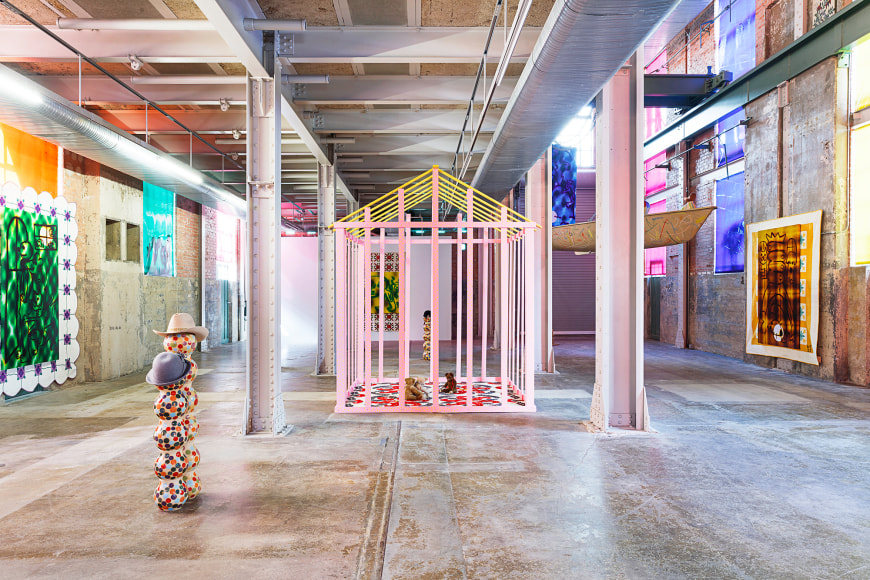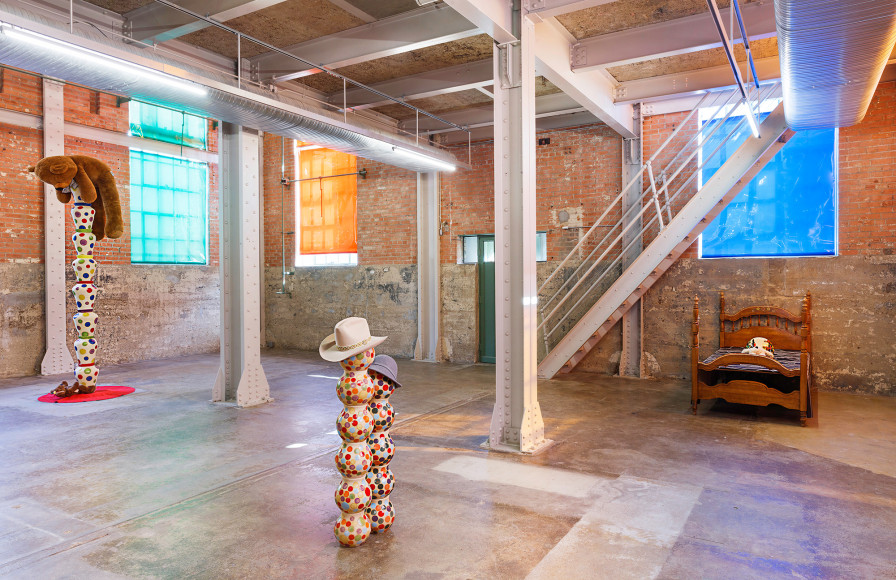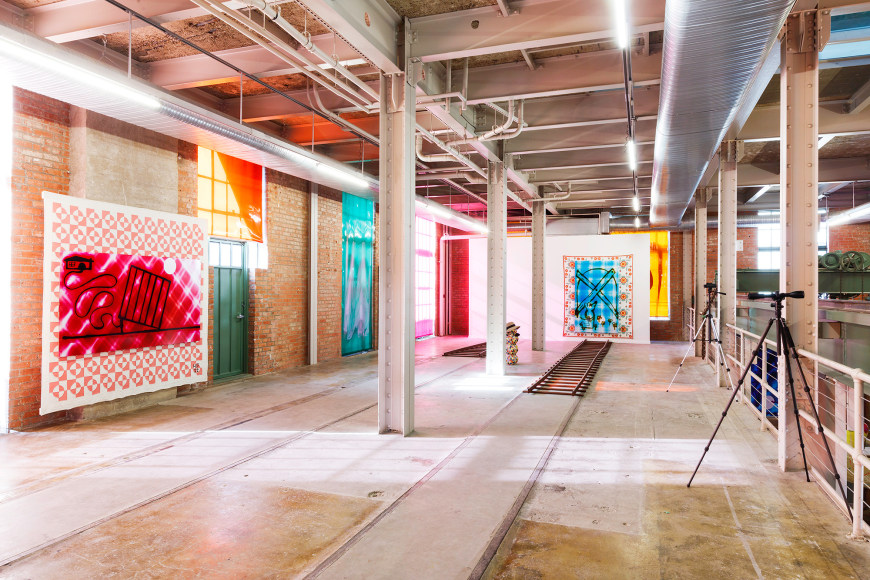“A child in the dark, gripped with fear, comforts himself by singing under his breath. He walks and halts to his song. Lost, he takes shelter, or orients himself with his little song as best he can. The song is like a rough sketch of a calming and stabilizing, calm and stable, center in the heart of chaos. Perhaps the child skips as he sings, hastens or slows his pace. But the song itself is already a skip: it jumps from chaos to the beginnings of order in chaos and is in danger of breaking apart at any moment.”
"Allegories," Walter Benjamin famously tells us, "are, in the realm of thoughts, what ruins are in the realm of things.” And, in the work of Hadi Fallahpisheh, allegory emerges in the tension between darkness and fable, where the sweet and apparent innocence of its subject quickly shifts from benign to perverse.
For Fallahpisheh, darkness is a material. “I practically grew up in a darkroom, a mysterious place that stank of chemicals. …a kind of jail.” His practice is multidisciplinary. He works across painting, photography, sculpture, performance and installation to shape narratives that read as fables. Each tell a story. But none square to any singular reading. They speak of things and the impermanence of their respective meanings. Empty and dim, like a vessel’s interior.
Fallahpisheh produces paintings in blackout conditions. What presents as quickly rendered linework, is in reality, hours spent in isolation with photosensitive paper, color gels and a flashlight. The subjects take the form of archetypes–a house, a bedroom or a landscape–inhabited by a cast of recurring characters–a human, a mouse, a cat and a dog. The works tell a story of a quasi-family unit in bouts of soft violence and conflict, where scenes of antagonism and togetherness play out against each other and recede to contrast-ing themes of defeat and victory, anxiety and certainty.
Throughout the exhibition, Fallahpisheh deploys clans of stued animals that suggest familial units. They are seen blissfully wide-eyed and wedged inside ceramic vessels. With Young and Clueless (a moniker Fallahpisheh has repeatedly ascribed to previous similar bodies of work and exhibitions.), two outer pots squeeze a third interior vessel, suspending the form mid-air. The soft, pliable object collides in hard, delicate forms.
Fallahpisheh’s work hinges on serialism and repetition–most directly in the stacked ceramic pots in Cou-ples, where a central spinal structure results from a series of playfully glazed anthropomorphized vessels. The totems flex avatar-like through height and headwear. And while the relational circumstances depicted in the pairings are unknown, they don’t forfeit a sense of the social or the possibility of exchange and communication.
Framing the photographs and sculptures are antique quilts. As symbols for warmth and shelter, textiles gesture to quaint interior decor and symbolic family heirlooms. As silent recorders that vibrate with memory and nostalgia, the quilt reflects each body it drapes and touches. Embellished with abstract imagery and playful pattern, the talisman recalls personal associations and memories.
Fallahpisheh is a storyteller. But the narratives that can easily be misinterpreted as sardonic or derisive are deliberately sympathetic. The cast of characters long for a sense of belonging and openness. In their world, Fallahpisheh cultivates an environment from darkness where things have a place and ground, like a voice in the dark singing into the light.
Hadi Fallahpisheh (b. 1987, Tehran, Iran) works in photography, sculpture and performance. His large-scale photographic works play on photography’s traditional role to reflect the society in which they were made, as well as the technical virtuosity that typically accompanies the medium.
Fallahpisheh received an MFA in photography at Bard College, Annandale-on-Hudson in 2016. He was a recipient of the Artadia New York Award and his work was recently part of Greater New York 2021 at MoMA PS1, and the 2022 Invitational Exhibition of Visual Arts at the Academy of Arts and Letters, New York. Recent museum exhibitions also include a solo presentation of work curated by Maika Pollock at the John Young Museum in Honolulu, Hawaii. Fallahpisheh has an upcoming The Pejman Foundation, Tehran and will be opening a concurrent solo exhibition at the Power Station in Dallas.
From 20182021 Fallahpisheh was a teaching fellow at Harvard University, and was a guest lecturer as part of Barnard University's Fellowship Lecture for Emerging Art. He has also been a guest lecturer at Princeton University, the New School, Pratt and The Cooper Union. Fallahpisheh’s work has been featured in ARTFORUM, Mouse Magazine, Forbes, Cultured Magazine, Flash Art, Bidoun, The Brooklyn Rail, The New York Times, and Art Review, among others. From 20182021 he was a teaching fellow at Harvard University, and was a guest lecturer as part of Barnard University's Fel-lowship Lecture for Emerging Art. He has been a guest lecturer at Princeton University, Barnard, the New School, Pratt and The Cooper Union. Fallahpisheh lives and works in Brooklyn, NY.
Also on view:
Guest, a new series of public sculptures for the Katy Trail, Dallas For the Katy Trail, Hadi Fallahpisheh presents Guest, a series of four uniquely crafted and boldly painted monumental steel sculptures. These towering shapes of steel will take up residence all along the Katy Trail, marking the distances and animating the changing landscape. Fallahpisheh often grapples with issues of authority and vulnerability in his work as he deconstructs and reassembles human and animal forms.
Pushing the boundaries of material and composition, Fallahpisheh has created these works to be in dia-logue with the trail and landscape, and in a constant state of change due to the passage of time, the pres-ence of a breeze, or the shifting angles of the sun. Each piece conveys a sense of tangible movement and aliveness despite their physical stasis; it is as if they spring from their pedestals. Each Guest carries a vase between their hands, a gift or offering, that spins in the wind, creating an ever changing silhouette. Their forms exist in an in-between state of coming and going, alluding to the daily comings and goings of people walking and running on the trail. With bright alternating colors, and a childlike sensibility, Guest brings sweeping curves and colorful pattern to the lush landscape of Dallas, and the Katy Trail.






